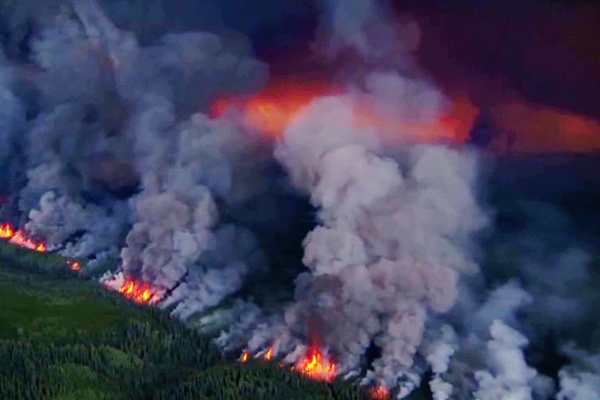EDMONTON/YELLOWKNIFE, Northwest Territories, Aug 18 (Reuters) – On Friday, residents of the remote northern Canadian city of Yellowknife attempted to flee before flames barred their path, while another wildfire in British Columbia’s western region triggered further evacuation orders.
Early Friday, a state of emergency was issued in and around Kelowna, a city roughly 300 kilometers (180 miles) east of Vancouver with a population of about 150,000 people. The following 24 to 48 hours, according to officials, could be the most difficult. The airspace was restricted to allow water bombs to land.
After wildfires that had been blazing since Tuesday jumped Lake Okanagan and moved into parts of Kelowna, some of the hills around the city flared in the predawn light.
“We fought hard last night to protect our community,” West Kelowna fire chief Jason Brolund told reporters. “Night turned to day because of the orange glow of the clouds and fire.”
According to officials, almost 2,400 properties have been evacuated, and thousands more are on standby to leave with little notice if necessary. Several structures in West Kelowna were demolished during the night, he added.
“Today will be another difficult day.” “The winds are stronger today than they were yesterday,” remarked Brolund. “People are going to see that glow again” on Friday night, “and it’s going to look worse than you ever expected,” he continued.
The size of the fires, as well as the disturbance to life and property, highlight the severity of this year’s worst-on-record Canadian wildfire season, with more than 1,000 active fires blazing throughout the nation.
The enormous conflagration threatening Yellowknife, the capital city of the Northwest Territories, made minimal progress on Friday due to good firefighting, the territorial fire department reported.
However, strong winds anticipated for Friday and Saturday continue to carry the fire toward the city, and it may reach the outskirts by the weekend. “Critical, challenging days” are ahead, according to the fire department.
The fire is around 15 kilometers (9 miles) northwest of Yellowknife, and the smoke smell is strong. Fires have been raging on both sides of the sole road out of town that has remained open.
“It’s on fire on both sides of the road… it’s a very surreal experience,” Brent Saulnier, a visitor, said.
Many people remain stranded in the 20,000-person city, with the evacuation deadline set for noon local time (1800 GMT).
“The noon deadline does not mean that the highway closes at noon,” Yellowknife Mayor Rebecca Alty told the Canadian Broadcasting Corporation. “We’re just encouraging people to go as soon as possible.” The highway will remain open as long as it is safe.”
Flights will also continue after the deadline, according to Alty.
Calgary, Alberta, received 15 evacuee planes from the Northwest Territories on Thursday and expects an additional 26 flights bringing around 2,300 people on Friday, according to the city. On Thursday, the Canadian military evacuated 79 people, with more flights expected for Friday.
Approximately 65% of the Northwest Territories’ 46,000 total population appeared ready to be evacuated. According to his office, Prime Minister Justin Trudeau will visit a wildfire evacuation center later on Friday.
According to the fire department, workers were cutting down vegetation to make fire breaks, installing sprinkler systems, and starting purposeful burns to reduce fuel before the larger blaze arrived.
CONDITIONS OF DRYNESS
According to experts, climate change has increased the wildfire situation. According to officials, drought and high temperatures have contributed to the quantity and intensity of fires this year. Much of Canada has had unusually dry conditions.
Responding to complaints over Facebook parent company Meta Platform’s suppression of critical fire news during a disagreement with the federal government over a law requiring income-sharing with local media, Transport Minister Pablo Rodriguez urged Meta on Friday to allow news to be shared.
As the number of refugees in Grande Prairie and St. Albert, on Edmonton’s northern suburbs, grew, both communities stated that their facilities had reached capacity and transferred all inbound evacuees to a new center in Leduc, south of the provincial capital.
The Gour family from Hay River was one of them.
When the family received an alert on their phones while camping, they were unsure where their son, Liam, 13, would land when he returned from a cadet excursion in the neighboring province of Yukon.
What mattered most to Paula Gour as the family made their way into Alberta was her family.
“The only thing on my mind was that I had the kids, the dogs, and each other, and I just wanted to get out of there.” “That’s all you can think about at the time,” she explained.
Dan Whitcomb and Timon Johnson contributed reporting. In Ottawa, David Ljunggren, Ismail Shakil, and Steve Scherer contributed reporting. Denny Thomas, David Ljunggren, and Steve Scherer contributed writing. Sharon Singleton, Chizu Nomiyama, Jonathan Oatis, and Josie Kao edited the piece.

